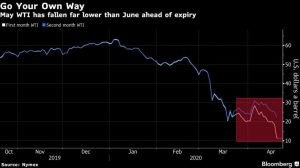APRIL 20, 2020

Oil plunged to the lowest level since 1986 as a deadly pandemic ravaging global economies threatens to erase an entire decade of demand growth, slashing thousands of jobs and wiping out hundreds of billions of dollars from company valuations.
Traders fled the May contract ahead of Tuesday’s expiration. Industrial and economic activity is grinding to a halt as governments around the globe extend shutdowns due to the swift spread of the coronavirus. Oil has faced its own knock-on effects with a market massively oversupplied and nowhere to put physical barrels. Despite the unprecedented output deal by OPEC and allied members a week ago to curb supply, it’s become too little too late in the face of pandemic lockdowns reducing global crude demand by about a third.
“There is little to prevent the physical market from the further acute downside path over the near term,” said Michael Tran, managing director of global energy strategy at RBC Capital Markets. “Refiners are rejecting barrels at a historic pace and with U.S. storage levels sprinting to the brim, market forces will inflict further pain until either we hit rock bottom, or COVID clears, whichever comes first, but it looks like the former.”
Since the start of the year, oil prices have fallen by more than 80%, or $50 a barrel, after the compounding impacts of the coronavirus and a breakdown in the original OPEC+ agreement. With no end in sight, and producers around the world continuing to pump, that’s causing a fire-sale among traders who don’t have access to storage.
There are signs of weakness everywhere. Buyers in Texas are offering as little as $2 a barrel for some oil streams, raising the possibility that producers may soon have to pay to have crude taken off their hands. The spread between the nearest two contracts for the U.S. benchmark has fallen to its weakest level on record. In Asia, bankers are increasingly reluctant to give commodity traders the credit to survive as lenders grow ever more fearful about the risk of a catastrophic default.

May WTI has fallen far lower than June ahead of expiry. – Bloomberg
In New York, West Texas Intermediate dropped by a staggering 43%, the most since the contract began trading in 1983, to $10.34 a barrel, the weakest level since 1986. The plunge was exaggerated as the May futures contract expires on Tuesday. The June contract fell 8.8% to $22.83 a barrel at 10:46 a.m. local time. Brent declined 5.1% to $26.64.
The S&P’s 500 Energy Index has lost nearly 45% since the start of the year as producers and refiners were pummeled by the oil plunge.
Crude stockpiles at Cushing — America’s key storage hub and delivery point of the West Texas Intermediate contract — have jumped 48% to almost 55 million barrels since the end of February. The hub had working storage capacity of 76 million as of Sept. 30, according to the Energy Information Administration.
Fund Inflow
Despite the weakness in headline prices, retail investors are continuing to plow money back into oil futures. The U.S. Oil Fund ETF saw a record $552 million come in on Friday, taking total inflows last week to $1.6 billion.
The price collapse is reverberating across the oil industry. Crude explorers shut down 13% of the American drilling fleet last week. While production cuts in the country are gaining pace, it isn’t happening quickly enough to avoid storage filling to maximum levels, said Paul Horsnell, head of commodities at Standard Chartered.
”The background psychology right now is just massively bearish,” Michael Lynch, president of Strategic Energy & Economic Research Inc said in a phone interview. “People are concerned that we are going to see so much build up of inventory that it’s going to be very difficult to fix in the near term and there is going to be a lot distressed cargoes on the market. People are trying to get rid of the oil and there are no buyers.”
Courtesy/Source: Bloomberg

































































































